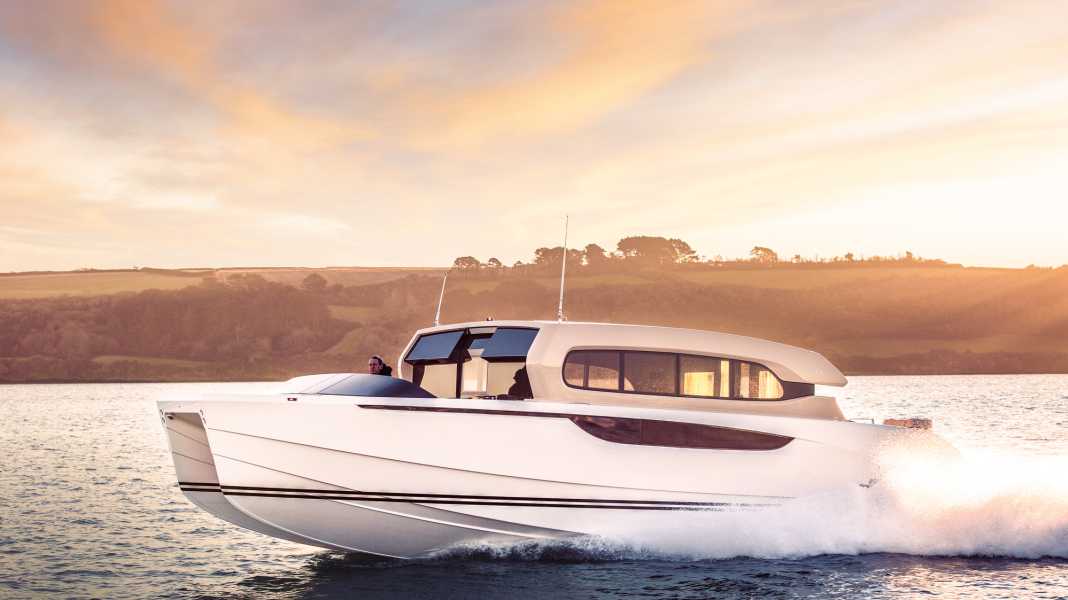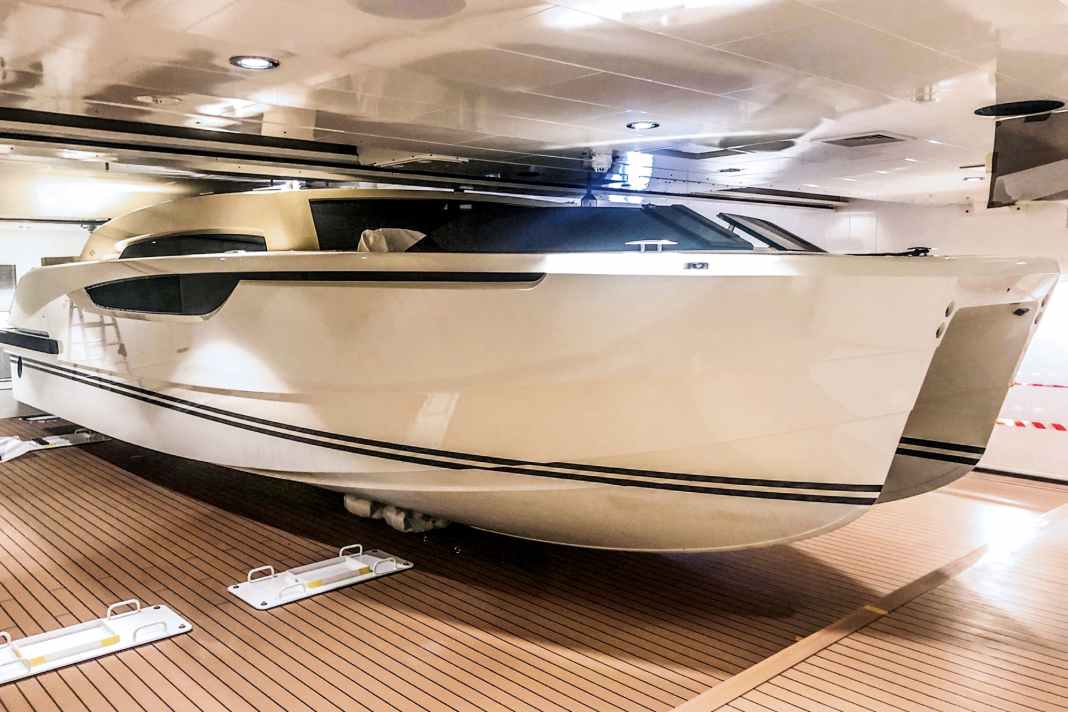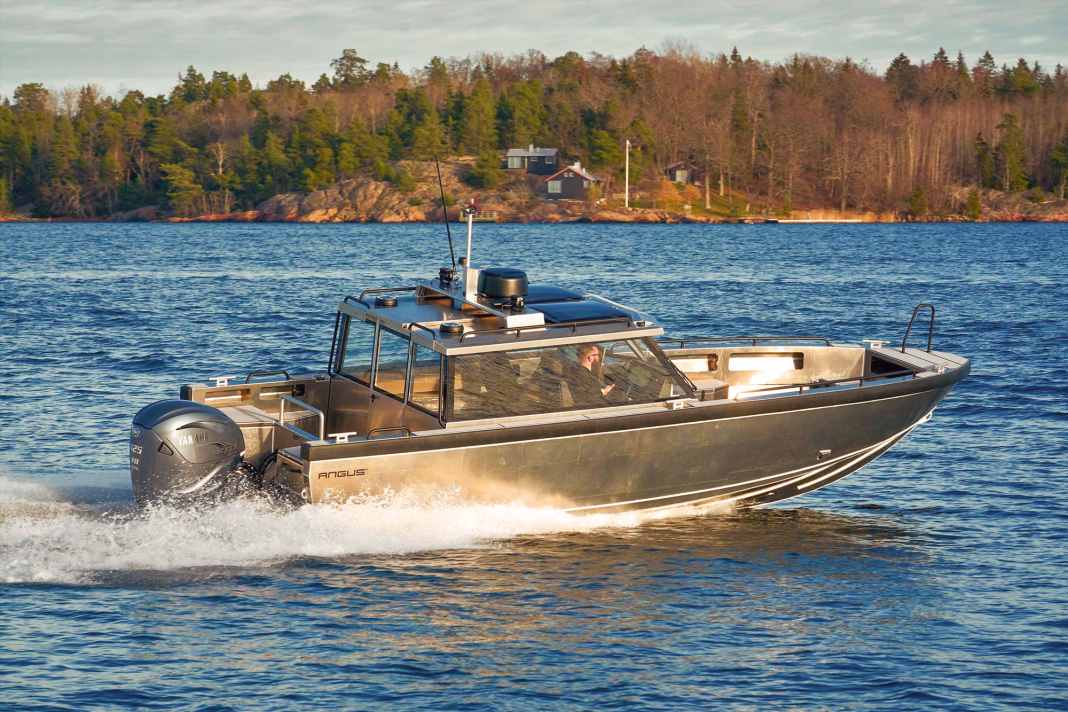
For 50-knot fast tender trips into the blue



The halls of Cockwells in Falmouth have already produced many a dinghy customised down to the smallest detail. With the two catamaran tenders for the Lürssen Giga "Blue", the more than 100 employees have now delivered their magnum opus for the time being. Cockwells Modern & Classic Boatbuilding, the full name of the shipyard founded in Cornwall in 1996, laminated an 11.70 metre long open and a 12.30 metre long saloon - the longest and fastest in the company's history.
The in-house designers were given the creative brief by Terence Disdale, who designed the 160 metre long mother ship with a very classic exterior. This makes it all the more surprising that the enclosed satellite with its modern deckhouse is surprisingly different. The fully air-conditioned environment offers space for twelve people, who can reach the helmsman via sliding doors at the front or the cockpit and boarding gate aft. Although you would think that the steel hull of "Blue" offers plenty of space, the superstructure and the carbon T-top lower electronically for reduced parking dimensions. Both the Limo and the Open have an automatic water ballast system for comfortable transfer and stable boarding via the stern or alongside.
The tenders are each approved for three crew members who carry out high-speed transfers at over 50 knots. Asymmetrical hulls, waterjets and an identical motorisation of two Volvo Pentas, each with 533 kilowatts of power, ensure this on the 8.5-tonne vessels. The waterjet drives result in draughts of just 60 centimetres. To land in shallow bays, the open model approaches with the bow in front, from which a ramp folds down hydraulically onto the beach. It is then manoeuvred using a joystick and the system is controlled via touchscreens, just like the larger models. Cockwells derived a 13 metre long and 42 knot dayboat concept from the "Blue" tender, with a front and aft cockpit.
Comfortable aluminium coupé from Scandinavia




In Scandinavia, boats made of aluminium are as popular as those made of GRP in Germany. So Angus Marine is by no means occupying a niche. As far as the external look is concerned, however, it does. Behind the new brand is the Swede Thomas Rönnberg, who founded Rupert Marine and developed his very own aesthetic for his tenders and military RIBs. The nine-metre-long A85 Coupé has an open and comfortable appearance with an all-round glazed superstructure, yet still exudes that aggressive and dynamic Rupert charm.
All models, including the A95 and A70, are built to the same standards as workboats, with all-round fender rails, plenty of rocker rails inside and out and hulls made of six millimetre thick aluminium sheet. All welding takes place in northern Finland, with final assembly in Sweden. Rönnberg consulted an acoustician who prescribed a sound- and heat-insulated cabin mounted on elastic rubber buffers. The design of the control stand with sprung seats and the arrangement of the steering wheel and controls - rotary switches meet screens - are designed for a high level of ergonomics. Outboards between 220 and 330 kilowatts are recommended for the 2.6 tonne displacement A85, which are powered by a 400 litre tank. Angus is also planning an A95: the same concept, but with two berths in the bow.
Take off sitting comfortably



Is it a board or a boat? It's certainly one that takes off. The manufacturer calls the 200 x 80 centimetre flat-bottomed hull a seatfoiler. The idea of relaxed flying over water came from a mechanical engineering graduate from TU Delft. A five-kilowatt electric motor sits behind the propeller, which hangs in a cage at the lower end of the 80-centimetre-long mast. Thanks to a main wing with a wingspan of 99 centimetres, pilots weighing up to 105 kilograms should be able to fly at speeds as low as five knots.
The top speed is ten knots. Not much, but the 1.6-kilowatt-hour battery allows for two hours of long trips. The stable flight attitude is achieved by leaning the upper body forwards and backwards, steered by shifting weight. The thrust is regulated by a specially developed transmitter for the thumb, which has been cleverly integrated into the starboard handle and only responds on contact with the magnetic key. The Seatfoiler weighs 35 kilograms, is manufactured in the Netherlands and costs 12,500 euros including VAT.

